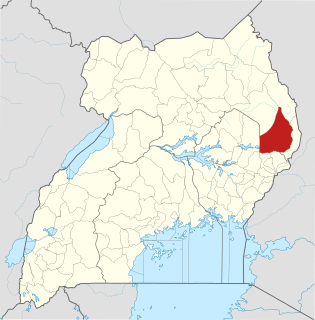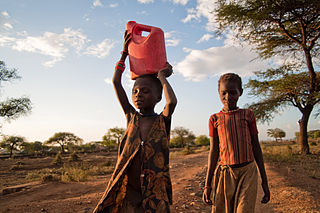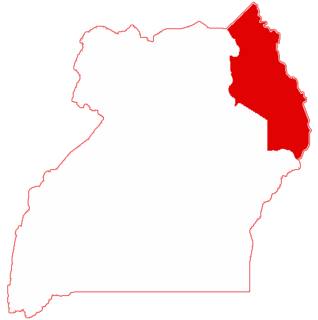Karamojong may refer to:
| This disambiguation page lists articles associated with the title Karamojong. If an internal link led you here, you may wish to change the link to point directly to the intended article. |
Karamojong may refer to:
| This disambiguation page lists articles associated with the title Karamojong. If an internal link led you here, you may wish to change the link to point directly to the intended article. |
The Oropom were the aboriginal inhabitants of much of Karamoja in Uganda, Mt. Elgon area and West Pokot, Trans Nzoia and Turkana regions in Kenya. Their descendants were largely assimilated into various communities present in their former territories, including the Iteso, Karamojong, Pokot, Turkana and Bukusu. They are or were found in scattered pockets between the Turkwel River, Chemorongit Mountains and Mt. Elgon. One report indicates that they formerly spoke the unclassified Oropom language.

Nakapiripirit District is a district in Northern Uganda. Like many other Ugandan districts, it is named after its 'chief town', Nakapiripirit, where the district headquarters are located.

Kapchorwa District is a district in the Eastern Region of Uganda. The town of Kapchorwa is the district's main municipal, administrative, and commercial center, and is the site of the district headquarters. It is also the home district of Stephen Kiprotich, men's marathon gold medalist at the 2012 Olympic Games in London.

Uganda is a multilingual country. Forty three of its living languages fall into four main families—Bantu, Nilotic and Central Sudanic—with another two languages in the Kuliak family. Of these, 41 are indigenous and 2 are non-indigenous. Furthermore, 5 are institutional, 27 are developing, 7 are vigorous, 2 are in trouble, and 2 are dying.
Turkana is the language of the Turkana people of Kenya. It is spoken in northwestern Kenya, primarily in Turkana County, which lies west of Lake Turkana. It is one of the Eastern Nilotic languages, and is closely related to Karamojong, Jie and Teso of Uganda, to Toposa spoken in the extreme southeast of South Sudan, and to Nyangatom in the South Sudan/Ethiopia Omo valley borderland; these languages together form the cluster of Teso–Turkana languages.

The Karamojong or Karimojong are an ethnic group of agro-pastoral herders living mainly in the north-east of Uganda. Their language is also known as Karamojong or Karimojong, and is part of the Nilo-Saharan language group.
The Iteso are an ethnic group in eastern Uganda and western Kenya. Teso refers to the traditional homeland of the Iteso, and Ateso is their language. Iteso is plural, Etesot and Atesot are singular. Etesot is for male person from Teso and Atesot is feminine. Iteso are believed to have migrated from Abyssinia (Ethiopia).

Ateker, or ŋaTekerin, is a common name for the closely related Jie, Karamojong, Turkana, Toposa, Nyangatom and Teso peoples and their languages. These ethnic groups inhabit an area across Uganda and Kenya. Itung'a and Teso have been used among ethnographers, while the term Teso-Turkana is sometimes used for the languages, which are of Eastern Nilotic stock. Ateker means 'clan' or 'tribe' in the Teso language. In the Lango language, the word for clan is atekere.

Karamoja sub-region, commonly known as Karamoja, is a region in Uganda.

The Nyangatom also known as Donyiro and pejoratively as Bumé are Nilotic agro-pastoralists inhabiting the border of southwestern Ethiopia and southeastern South Sudan and in the Ilemi Triangle with populations residing in both countries. They speak the Nyangatom language.

Amuria is a town in the Eastern Region of Uganda. It is the chief municipal, administrative, and commercial center of Amuria District, in the Teso sub-region.
Lango is a Southern Luo dialect spoken by the Lango people of Uganda. The word "Lango" is used to describe both the language spoken by the indigenous and tribe itself It is mostly spoken in Lango sub-region, in the Northern Region, by approximately 1.8 million speakers, or five percent of the population of Uganda. An orthography for it using the Latin script has been introduced and is taught in primary schools. It is generally counted as a distinct language because the Lango people are ethnically distinct from other Luo. The language shares a similar dialect with the broader Luo speaking people such as the Acholi, Alur, and Adoalh of Uganda. However, the origin of Lango People is strongly linked to the tradition of Shilluk, Karamojong and Teso speaking people.
Nadiket Seminary, aka St. Mary's Seminary, Nadiket, located about 3 km (1.9 mi) on the Moroto-Kitale road Uganda, is a Catholic institution where young men are trained to the priesthood.
Uganda is a source and destination country for men, women, and children trafficked for the purposes of forced labor and sexual exploitation. Ugandan children are trafficked within the country, as well as to Canada, Egypt, the United Arab Emirates, and Saudi Arabia for forced labor and commercial sexual exploitation. Karamojong women and children are sold in cattle markets or by intermediaries and forced into situations of domestic servitude, sexual exploitation, herding, and begging. Security companies in Kampala recruit Ugandans to serve as security guards in Iraq where, at times, their travel documents and pay have reportedly been withheld as a means to prevent their departure. These cases may constitute trafficking.
The Karamojong language is a Nilo-Saharan language spoken mainly in the Karamoja subregion of north-eastern Uganda.
Nyang'i (Nyangia) is the nearly extinct Kuliak language of the Nyangea hunter-gatherers of northeastern Uganda. The 15,000 Nyangia have shifted to speaking Karamojong.
The Kadam people inhabit Mount Kadam in Nakapiripirit District in the Karamoja sub-region, located in north-eastern Uganda.
The Jie are an ethnic group of Uganda. They belong to the Karamojong Cluster, which also includes the Karamojong and Dodoth people. Their country in northeast Uganda lies between the Dodoth to the north and the Karamojong to the south.
The Dodoth are an ethnic group in north eastern Uganda. They belong to the Karamojong Cluster, which also includes the Karamojong and Jie people. Their language is a dialect of the Karamojong language.
Losilang is a Sub-County in Kotido District of northern Uganda. It lies to the northeast of Kotido town. It has an area of 144.3 square kilometres (55.7 sq mi). Estimated population in 2009 was 17,000. Losilang was one of the early centers of the Karamojong cluster of related people. From here, the Toposa people drifted northeast and then west to settle in Kapoeta by 1830. In more recent times, Losilang has been the scene of clashes between armed warriors and Uganda People's Defence Force (UPDF) troops seeking illegal arms and property. On 19 May 2006 there were several hours of fighting, between 200 and 500 houses were burned down and several civilians died.